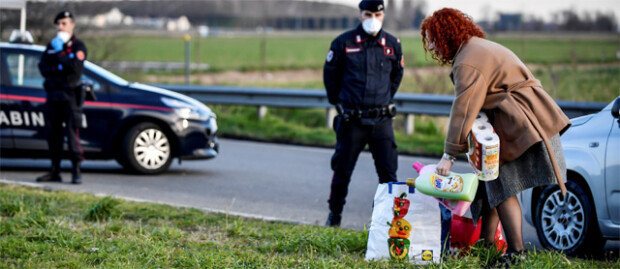Coronavirus outbreak sparks chaos in Italy
Coronavirus outbreak sparks chaos in Italy
Posted March. 10, 2020 07:43,
Updated March. 10, 2020 07:43

The number of daily coronavirus cases soared in Italy to almost 1,500 on Sunday. With the Italian government imposing a lockdown in the northern regions, people started to flee south, adding to the chaos.
According to Italian health authorities, the number of confirmed cases in the country rose by 1,492 to 7,375 on Sunday. Given the situation, it is likely that Italy is going to have more confirmed coronavirus cases than South Korea (7,382) sooner or later. Italy’s death toll was up 133 to 366 on the day. The Italian government put 16 million people in Lombardy and 14 other provinces on lockdown the previous day but failed to discourage the rapid surge in confirmed coronavirus cases.
The problem is the rapid surge in coronavirus infections is intensifying social chaos. The Guardian reported that thousands in the northern regions, including Milan and Venice, jumped into their cars to flee south after decree to confine people was revealed. Train stations were also crowded with people trying to flee as the document sent by Prime Minister Giuseppe Conte to local governments was leaked to the press.
“What happened with the news leak has caused many people to try to escape, causing the opposite effect of what the decree is trying to achieve,” said a virology professor in Milan. The situation is growing into a regional conflict between south and north. Michele Emiliano, the president of Puglia, criticized those fleeing south, telling them to go back as they are “carrying the virus” into south.
The reasons behind the rapid spread of COVID-19 in Italy include commercial intercourse with China, optimistic characteristics of Italians, and population aging. Local media reports that poor response by the Italian government has worsened the catastrophe.
As many as 300,000 Chinese live in Italy, the fourth highest number in Europe. Most of them live in the fashion city of Milan and the industrial city of Prato, as most Chinese people working at textile factories are living under poor sanitary conditions. “Infections must have been easily spread and it is hard to trace back the source of infection since multiple people share a room,” a local source said.
The optimistic and individualistic characteristics of Italians worked against Italy’s efforts to contain the virus. The Wall Street Journal reported that ski resorts in the affected areas were packed with people until recently and bars in Milan hosted parties, adding that despite government warnings, many Italians have continued on with business as usual under the motto, “Milan won’t stop.”
Aging population has added to the spread of COVID-19. Population aged 65 and above in Italy was reported at 22.75% in 2018, the second highest following Japan. The coronavirus has spread rapidly in Italy due to Italy’s large elderly population with low level of immunity. Italy also has relatively weak health care system.
“Italy has a lower number of doctors and nurses, and a low accessibility to medical services,” said Seol Dae-woo, professor of Pharmaceutical Sciences at Chung-Ang University. The Italian government’s poor response has added to the damage. Italy has yet to identify patient zero. Choi Won-seok, professor of infectious diseases division at Korea University, said the spread of coronavirus in Italy would not have been so rapid if the country had identified patient zero and source of infection, and taken preventive measures.
zozo@donga.com · jyr0101@donga.com
Headline News
- Med professors announce intention to leave hospitals starting Thursday
- Bridge honoring Sgt. Moon Jae-sik unveiled in Pennsylvania
- Chief of Staff Chung tells presidential secretaries to stay away from politics
- US FTC bans noncompete agreements
- N. Korea launches cyberattacks on S. Korea's defense companies







